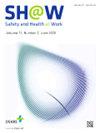基于预防文化的信任领先指标与主动领先指标适应性探索性研究
IF 2.9
3区 医学
Q1 PUBLIC, ENVIRONMENTAL & OCCUPATIONAL HEALTH
引用次数: 0
摘要
本研究探讨了信任领先指标(TLI)和主动领先指标(PLI)在韩国工业中的适用性,这是作为“零愿景”(一项传播预防文化的全球运动)的一部分而开发的。比较了这些指标与安全文化相关变量(如安全气候、安全行为、风险感知和事故经验)之间的关系。方法研究样本包括韩国大型制造工厂下属的12家分包商的630名工人。研究主要变量之间的相关性,包括基于主观事故经验的TLI和PLI的组间差异。结果TLI和PLI与安全气候和安全行为子因子显著正相关,与风险感知子因子显著负相关,表明它们作为现有安全文化指标的延伸具有潜在的效用。TLI和PLI在事故经历水平上有显著差异。尽管存在局限性,例如由于行业性质和使用主观事故经验而不是官方工业事故数据,研究中男性工人占主导地位,但本研究具有重要意义,因为它探讨了韩国工业中预防文化的两个主要指标的适用性,确认了这些指标在各种文化背景下的潜在效用,并有助于全球努力传播预防文化。本文章由计算机程序翻译,如有差异,请以英文原文为准。
Exploratory Study for the Adaptability of Trust Leading Indicator and Proactive Leading Indicator Based on Prevention Culture
Background
This study explored the applicability of the Trust Leading Indicator (TLI) and Proactive Leading Indicator (PLI), developed as part of the Vision Zero, a global campaign for the dissemination of prevention culture, in Korean industries. The relationship between these indicators and safety culture-related variables were compared, such as safety climate, safety behavior, risk perception, and accident experience.
Methods
The study sample comprised 630 workers from 12 subcontractors affiliated with the Republic of Korea's large manufacturing plant. Correlations among the main variables were examined, including group differences in TLI and PLI based on subjective accident experience.
Results
The TLI and PLI had significant positive correlations with the sub-factors of safety climate and safety behavior and negative correlations with risk perception, indicating their potential utility as extensions of existing safety culture indicators. A significant difference in TLI and PLI was observed across accident experience levels.
Conclusion
Despite limitations, such as the predominance of male workers in the study owing to the nature of the industry and use of subjective accident experience rather than official industrial accident data, this study is significant as it explores the applicability of the two leading indicators of prevention culture in Korean industries, confirming the potential utility of these indicators across various cultural contexts and contributing to global efforts to disseminate a prevention culture.
求助全文
通过发布文献求助,成功后即可免费获取论文全文。
去求助
来源期刊

Safety and Health at Work
Social Sciences-Safety Research
CiteScore
6.40
自引率
5.70%
发文量
1080
审稿时长
38 days
期刊介绍:
Safety and Health at Work (SH@W) is an international, peer-reviewed, interdisciplinary journal published quarterly in English beginning in 2010. The journal is aimed at providing grounds for the exchange of ideas and data developed through research experience in the broad field of occupational health and safety. Articles may deal with scientific research to improve workers'' health and safety by eliminating occupational accidents and diseases, pursuing a better working life, and creating a safe and comfortable working environment. The journal focuses primarily on original articles across the whole scope of occupational health and safety, but also welcomes up-to-date review papers and short communications and commentaries on urgent issues and case studies on unique epidemiological survey, methods of accident investigation, and analysis. High priority will be given to articles on occupational epidemiology, medicine, hygiene, toxicology, nursing and health services, work safety, ergonomics, work organization, engineering of safety (mechanical, electrical, chemical, and construction), safety management and policy, and studies related to economic evaluation and its social policy and organizational aspects. Its abbreviated title is Saf Health Work.
 求助内容:
求助内容: 应助结果提醒方式:
应助结果提醒方式:


